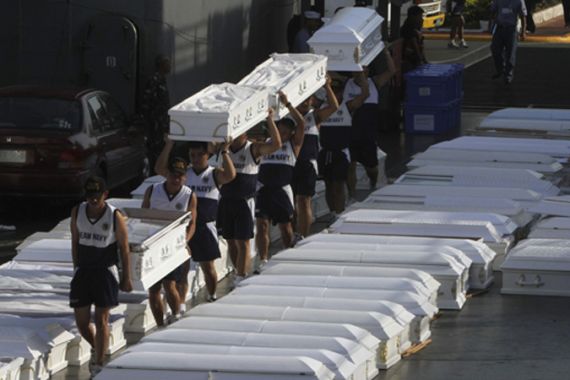Philippines declares ‘state of calamity’
President visits affected areas and authorities ready communal tombs as death toll from floods nears 1,000 people.

A state of national disaster has been declared in the Philippines, and authorities are preparing for temporary mass burials after nearly a thousand people died in recent floods.
At least 957 people are confirmed dead so far and 49 others are missing after tropical storm Washi lashed the southern island of Mindanao and surrounding areas over the weekend, said civil defence chief Benito Ramos.
Keep reading
list of 4 itemsAfter the Hurricane
World’s coral reefs face global bleaching crisis
Why is Germany maintaining economic ties with China?
Washi brought heavy rains that swelled rivers, unleashing flash floods and landslides in the middle of the night and swept away shantytowns built near river mouths. The death toll rose sharply as the bodies of people who were swept out to sea were recovered.
President Benigno Aquino flew to Mindanao on Tuesday to survey the devastation by air, co-ordinate the relief effort, and express his condolences to the victims’ relatives, aides said.
Aquino said the impoverished nation of 94 million people was now in a “state of calamity”, his spokesman Ricky Carandang told reporters.
Iligan and Cagayan de Oro are the worst affected cities, with 279 and 579 fatalities respectively; but other areas were also hit and needed immediate aid from the national government, Carandang said.
Aquino, speaking to residents in the city of Cagayan de Oro, said: “Our national government will do its best to prevent a repeat of this tragedy.”
He said there would be an assessment of what went wrong and why so many people died.
“I do not accept that everything had been done. I know that we can do more. We must determine what really happened,” Aquino said.
But “for many of the people here, it’s four days too late,” said Al Jazeera’s Marga Ortigas, reporting the reaction on the ground in the southern port city of Iligan.
“They say that [the president’s] leadership style is a bit too relaxed, and they would have appreciated a bit more direction and attention from him personally in the early days of the weekend when this flood first struck,” she added.
Temporary tombs
 |
| Iligan is one of the worst affected cities [AFP] |
Authorities in both cities were preparing mass burials of unidentified bodies by placing them in temporary “communal tombs” Ortigas said. The government had shipped more than 400 coffins to the two cities.
“Already, local governments are preparing mass burials. They are not just going to be throwing the bodies into a grave in the ground. What they have done is they are trying to identify as many of them as they can.”
Officials would document bodies they had not been able to identify before putting the remains into communal tombs above the ground, our correspondent said.
“This is a way by which they say they can honour each person individually until either relatives come to claim those that are still unclaimed,” she said. Those that remained unclaimed would eventually be interred in more permanent graves, she added.
Richard Gordon, chairman of the Philippine Red Cross told Al Jazeera: “The situation is very grim.. There are many people who have lost their homes, lost their families. A lot of them are in dire straits, they are totally stressed out and they are in need of psychological support.
“The government in the past and in the present has failed to create new settlements in accordance with the law. The government should be preparing settlements instead of allowing [people] to get cramped up in the city itself. The government needs to bring investment to the countryside next to the city so people can go there and find safe settlement,” he added.
Our correspondent said more bodies were expected to be pulled out of the mud in the worst affected areas in the coming days, which would likely increase the death toll.
“The military has been sending soldiers here to try to already dig through what remains of the houses that used to stand here, and indeed go through the mud that now covers the entire village,” she reported from Iligan.
The disaster area, located about 800km from the capital Manila, is normally bypassed by typhoons that ravage other parts of the far-flung Philippine archipelago every year.
More than 284,000 people have been displaced by the storm with over 42,000 in crowded, makeshift government evacuation centres, the National Disaster Risk Reduction and Management Council said.